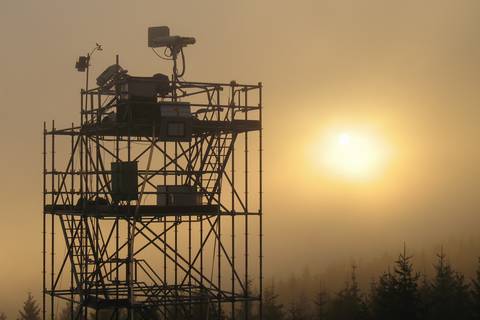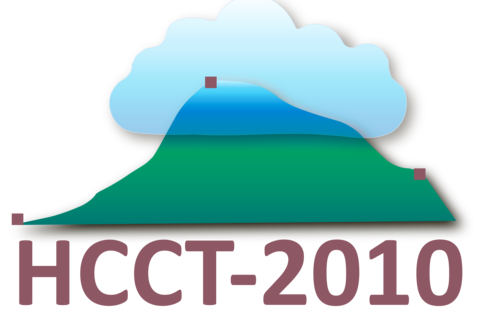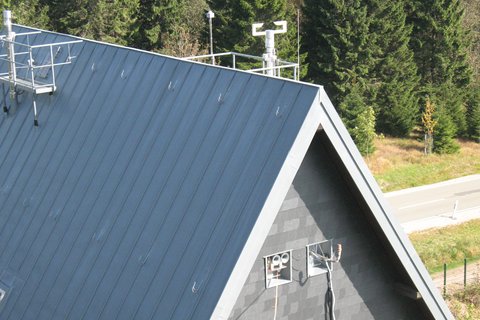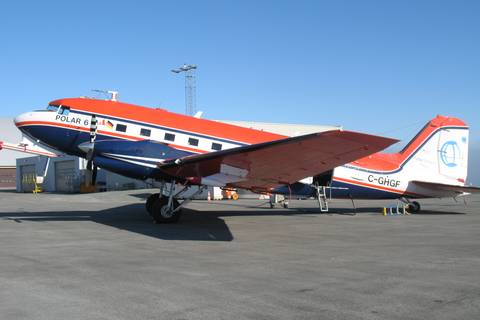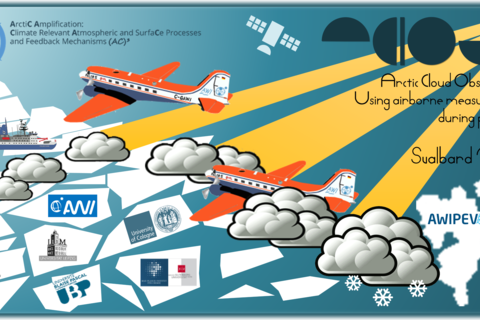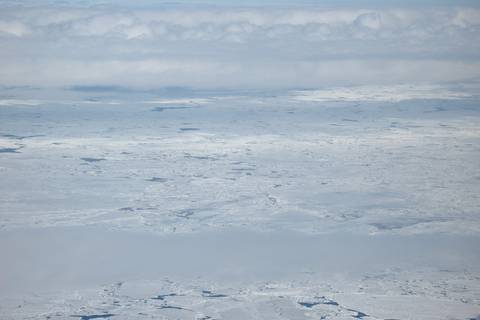For many years, TROPOS has participated in national and international cloud field measurement campaigns, which are part of research projects for the investigation of aerosol-cloud interactions in liquid clouds. These are orographic clouds, tropical trade wind clouds, low and medium high arctic clouds and cold but liquid strato cumulus clouds. The objectives of these field experiments are:
- Identification of the chemical and microphysical properties of aerosol particles that form/do not form cloud droplets in the real atmosphere (especially compared to particle activation in condensation nucleus counters)
- Quantification of the phase partitioning of atmospheric aerosol substances in the liquid and interstitial phase
- Determination of the effect of cloud processing on atmospheric aerosol particles (change of chemical composition and size)
- Provision of input and validation parameters for cloud chemistry and microphysical models
The experimental in-situ cloud investigations are carried out both on the ground (i.e. mainly at mountain measurement stations) and aircraft-borne. Inside the cloud the droplets and the interstitial aerosol are collected separately using a counterflow virtual impactor (CVI) and an interstitial inlet. After drying of the droplets in the airborne state within the CVI, both the droplet residues and the interstitial particles are analyzed microphysically (number, size) and chemically (composition, mixing state), also in cooperation with working groups of other research institutes. Research projects in which atmospheric liquid clouds are or have been studied are HCCT-2010 and ACLOUD.
HCCT-2010: Hill Cap Cloud Thuringia, Schmücke, Germany, ground-based (2010)
By measuring the microphysical and chemical properties of aerosol particles in front of the cloud, in the cloud (residual particles activated to droplets and non-activated interstitial particles) and after the cloud, it will be investigated which aerosol types contribute to cloud formation and which do not, and how activated aerosol particles are altered by cloud processing. Even though the actual measurement campaign dates back further, it is still all about the question which supersaturations exist in the real cloud, which cannot be measured directly, but is an essential parameter for cloud process modelling. This important parameter could be derived by comparing the size-resolved activation measurements of aerosol particles in a cloud condensation chamber before cloud entry with those in the real cloud (via the size distribution of the residual and interstitial particles).
This project was supported by the Deutsche Forschungsgemeinschaft (German Research Foundation) with human resources (project number 48902976).
ACLOUD: Svalbard, Arctic, airborne (2017)
There is strong evidence that low supercooled and mixed-phase clouds contribute significantly to increased Arctic warming. Therefore, a better understanding of the formation and stability of these Arctic clouds is needed. Closely related to cloud formation is the question on which Arctic aerosol particles these clouds form and what the sources of these cloud condensation nuclei are. For this purpose, measurements of droplet residuals and atmospheric aerosol particles below the clouds were carried out during the measurement campaign ACLOUD with the Polar 6 research aircraft of the Alfred Wegener Institute. It was observed that over the open ocean the cloud-forming particles originate almost exclusively from the boundary layer and are activated at the cloud base, while over lake ice there is an essential fraction of these particles that are mixed into the cloud from above and contribute to secondary droplet formation in higher cloud layers.
This project is funded by the German Research Foundation (DFG-Collaborative Research Center/Transregio 172, project B03)
Literature on HCCT-2010:
Schneider, J., S. Mertes, D. van Pinxteren, H. Herrmann and S. Borrmann (2017), Uptake of nitric acid, ammonia, and organics in orographic clouds: Mass spectrometric analyses of droplet residual and interstitial aerosol particles, Atmos. Chem. Phys.17: 1571-1593, DOI: doi:10.5194/acp-17-1571-2017
Roth, A., J. Schneider, T. Klimach, S. Mertes, D. van Pinxteren, H. Herrmann and S. Borrmann (2016), Aerosol properties, source identification, and cloud processing in orographic clouds measured by single particle mass spectrometry on a Central European mountain site during HCCT-2010, Atmos. Chem. Phys.16(2): 505-524, DOI: doi:10.5194/acp-16-505-2016
van Pinxteren, D., K. W. Fomba, S. Mertes, K. Müller, G. Spindler, J. Schneider, T. Lee, J. L. Collett and H. Herrmann (2016), Cloud water composition during HCCT-2010: Scavenging efficiencies, solute concentrations, and droplet size dependence of inorganic ions and dissolved organic carbon, Atmos. Chem. Phys.16: 3185–3205, DOI: doi:10.5194/acp-16-3185-2016
Whalley, L. K., D. Stone, I. J. George, S. Mertes, D. van Pinxteren, A. Tilgner, H. Herrmann, M. J. Evans and D. E. Heard (2015), The influence of clouds on radical concentrations: Observations and modelling studies of HOx during the Hill Cap Cloud Thuringia (HCCT) campaign in 2010, Atmos. Chem. Phys.15: 3289-3301, DOI: doi:10.5194/acp-15-3289-2015
Harris, E., B. Sinha, D. van Pinxteren, J. Schneider, L. Poulain, J. Collett, B. D´Anna, B. Fahlbusch, S. Foley, K. W. Fomba, C. George, T. Gnauk, S. Henning, T. Lee, S. Mertes, A. Roth, F. Stratmann, S. Borrmann, P. Hoppe and H. Herrmann (2014), In-cloud sulfate addition to single particles resolved with sulfur isotope analysis during HCCT-2010, Atmos. Chem. Phys.14: 4219-4235, DOI: doi:10.5194/acp-14-4219-2014
Henning, S., K. Dieckmann, K. Ignatius, M. Schäfer, P. Zedler, E. Harris, B. Sinha, D. van Pinxteren, S. Mertes, W. Birmili, M. Merkel, Z. Wu, A. Wiedensohler, H. Wex, H. Herrmann and F. Stratmann (2014), Influence of cloud processing on CCN activation behavior in the Thuringian Forest, Germany during HCCT-2010, Atmos. Chem. Phys.14: 7859-7868, DOI: doi:10.5194/acp-14-7859-2014
Tilgner, A., L. Schöne, P. Bräuer, D. van Pinxteren, E. Hoffmann, G. Spindler, S. A. Styler, S. Mertes, W. Birmili, R. Otto, M. Merkel, K. Weinhold, A. Wiedensohler, H. Deneke, R. Schrödner, R. Wolke, J. Schneider, W. Haunold, A. Engel, A. Wéber and H. Herrmann (2014), Comprehensive assessment of meteorological conditions and airflow connectivity during HCCT-2010, Atmos. Chem. Phys.14(Special Issue: HCCT-2010: A complex ground-based experiment on aerosol-cloud interaction): 9105-9128, DOI: doi:10.5194/acp-14-9105-2014
Harris, E., B. Sinha, D. van Pinxteren, A. Tilgner, W. Fomba, J. Schneider, A. Roth, T. Gnauk, B. Fahlbusch, S. Mertes, T. Lee, J. Collett, S. Foley, S. Borrmann, P. Hoppe and H. Herrmann (2013), Enhanced role of transition metal ion catalysis during in-cloud oxidation of SO2, Science340(6133): 727-730, DOI: doi:10.1126/science.1230911
Spiegel, J. K., F. Aemisegger, M. Scholl, F. G. Wienhold, J. L. Collett Jr., T. Lee, D. van Pinxteren, S. Mertes, A. Tilgner, H. Herrmann, R. A. Werner, N. Buchmann and W. Eugster (2012), Temporal evolution of stable water isotopologues in cloud droplets in a hill cap cloud in central Europe (HCCT-2010), Atmos. Chem. Phys.12(23): 11679-11694, DOI: doi:10.5194/acp-12-11679-2012
Spiegel, J. K., F. Aemisegger, M. Scholl, F. G. Wienhold, J. L. Collett Jr., T. Lee, D. van Pinxteren, S. Mertes, A. Tilgner, H. Herrmann, R. A. Werner, N. Buchmann and W. Eugster (2012), Stable water isotopologue ratios in fog and cloud droplets of liquid clouds are not size-dependent, Atmos. Chem. Phys.12(23): 9855-9863, DOI: doi:10.5194/acp-12-9855-2012
Literature on ACLOUD:
Wendisch, M., A. Macke, A. Ehrlich, C. Lüpkes, M. Mech, D. Chechin, K. Dethloff, C. Barrientos Velasco, H. Bozem, M. Brückner, H.-C. Clemen, S. Crewell, T. Donth, R. Dupuy, K. Ebell, U. Egerer, R. Engelmann, C. Engler, O. Eppers, M. Gehrmann, X. Gong, M. Gottschalk, C. Gourbeyre, H. Griesche, J. Hartmann, M. Hartmann, B. Heinold, A. Herber, H. Herrmann, G. Heygster, P. Hoor, S. Jafariserajehlou, E. Jäkel, E. Järvinen, O. Jourdan, U. Kästner, S. Kecorius, E.M. Knudsen, F. Köllner, J. Kretzschmar, L. Lelli, D. Leroy, M. Maturilli, L. Mei, S. Mertes, G. Mioche, R. Neuber, M. Nicolaus, T. Nomokonova, J. Notholt, M. Palm, M. van Pinxteren, J. Quaas, P. Richter, E. Ruiz-Donoso, M. Schäfer, K. Schmieder, M. Schnaiter, J. Schneider, A. Schwarzenböck, P. Seifert, M.D. Shupe, H. Siebert, G. Spreen, J. Stapf, F. Stratmann, T. Vogl, A. Welti, H. Wex, A. Wiedensohler, M. Zanatta and S. Zeppenfeld (2019), The Arctic cloud puzzle: Using ACLOUD/PASCAL multiplatform observations to unravel the role of clouds and aerosol particles in Arctic amplification, Bull. Amer. Meteor. Soc., 100, 841-871. doi: doi:10.1175/bams-d-18-0072.1, 10.1175/BAMS-D-18-0072.2 (Suppl.).
Ehrlich, A., M. Wendisch, C. Lüpkes, M. Buschmann, H. Bozem, D. Chechin, H.-C. Clemen, R. Dupuy, O. Eppers, J. Hartmann, A. Herber, E. Jäkel, E. Järvinen, O. Jourdan, U. Kästner, L.-L. Kliesch, F. Köllner, M. Mech, S. Mertes, R. Neuber, E. Ruiz-Donoso, M. Schnaiter, J. Schneider, J. Stapf and M. Zanatta (2019), A comprehensive in situ and remote sensing data set from the Arctic CLoud Observations Using airborne measurements during polar Day (ACLOUD) campaign, Earth Syst. Sci. Data, 11(4), 1853–1881. doi: doi:10.5194/essd-11-1853-2019.
Mertes, S., U. Kästner and A. Macke (2019), Airborne in-situ measurements of the aerosol absorption coefficient, aerosol particle number concentration and size distribution of cloud particle residuals and ambient aerosol particles during the ACLOUD campaign in May and June 2017, PANGAEA, doi:10.1594/PANGAEA.900403.

